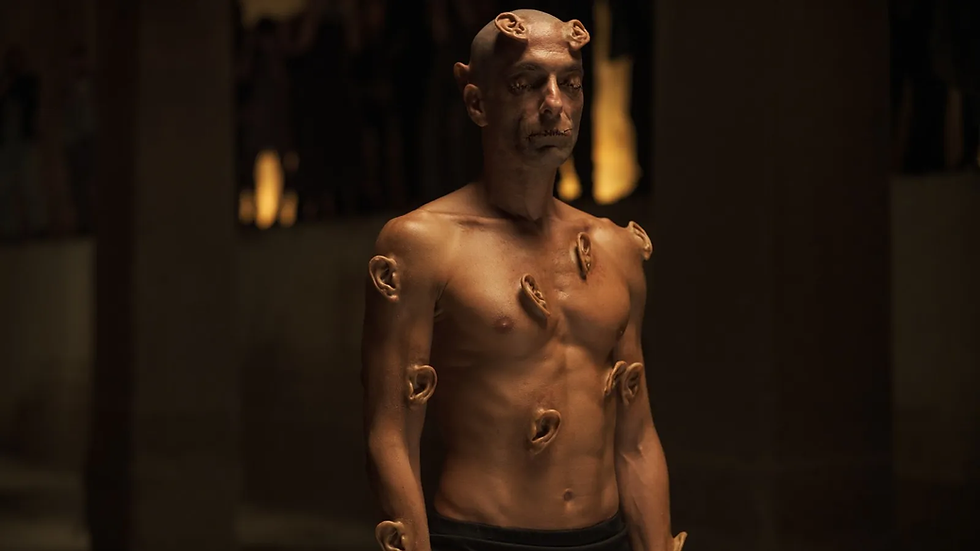'Crimes of the Future' Builds on Cronenberg's Triumphs of the Past
- Noah Moore

- Jun 11, 2022
- 4 min read
“BODY IS REALITY.”
Such adorns the monitors overlooking Saul Tenser’s exhibitionist surgery, a titillating new piece where, as expected, his partner Caprice removes a tattooed novel organ from his cornucopian innards. Tenser’s rapid bodily production of functional, yet alien “designer tumors” is our window into David Cronenberg’s vision of the future – a world without pain, where its absence stimulates a perverse sensual pleasure.

Crimes of the Future, Cronenberg’s first movie in eight years and first horror in 23, is a long-awaited return to the famed director’s roots after a series of mostly disappointing 21st-century features. Originally conceived in the late 90s as “Painkillers,” and set for production around 2002, this movie has been lingering in purgatory for quite some time. Finally, it’s here, updated for the modern world, and goodness is it good to have the King of Venereal Horror back.
Crimes certainly feels like the logical continuation of his horror career, as it’s most similar to his 90s features in tone (Crash) and set pieces (eXistenZ). But even beyond its general similarities to those two, there are nuggets of easily a half-dozen of his projects embedded within: the fleshy remote and corporeal zipper tonguing registers as an explicit reference to eXistenZ, the surgical appendages of Tenser’s machine to Dead Ringers, the factional navigation of dystopia to Scanners, the development of the theme of metamorphosis to The Fly and Videodrome, so on and so forth. Though the movie may not be Cronenberg’s greatest work, it absolutely reads like the culmination of his almost 50-year career.

Narrative focus is allotted primarily to Tenser, played by frequent Cronenberg collaborator Viggo Mortensen, and Caprice, Léa Seydoux, but often they function as a stand-in for the audience, familiar faces to follow through the dystopia. The primary plot involves Tenser’s struggle with his condition of “accelerated evolution syndrome,” as well as his interactions with a cabal of plastic eaters, the budding National Organ Registry, fellow performance artists, and several other factions, but the narrative falls secondary to other elements. The primary goal is to ease the audience into the world, luring us in with fleshy set-pieces and the most gorgeous imagery of the director’s oeuvre.
Through Tenser and Caprice’s artistry, Crimes serves as a directorial self-insert, a detached philosophical inquiry into the nature and role of artistic expression. Because of that approach, it can appear as if the central duo is being led around by little more than Cronenberg’s deviant curiosities, acting with little agency. With the more bizarre segments, the character-as-voyeur approach is incredibly effective. The “ear man,” with whom advertisement for the movie became nearly as synonymous as its tagline, is presented initially as a performance to watch, unencumbered by narrative. Only once his routine is in full swing do we find that Tenser is watching along with us.

Other times, the approach falls a little flat. The latter half of the movie becomes a series of loose interactions, wherein Tenser and/or Caprice are approached by odd figures with odd requests. Most important among them is Scott Speedman’s Lang Dotrice, who delivers the main narrative hook (in short, “please perform an autopsy on my weird, dead son”), but Kristen Stewart’s nervous, twitchy, “attractive-in-a-bureaucratic-way” Timlin steals the show. Her performance is chockablock with hilarious line-readings and perfect weirdo character choices. This is a movie with a sense of humor! It understands its inherent weirdness and often elects to diffuse the tension between the numerous surgery scenes.
And yes, there are quite a few graphic scenes. There is plenty of flesh-cutting, lips-sewing, knife-carving, bone-sawing, and some mild trepanation. Nobody is in pain, but if gashes are a particular visual phobia: avoid.

Crimes’ awareness of its strangeness does come at a price. Cronenberg worries that we won’t understand his vision; several haunting, fascinating, or otherwise inexplicable facets of the world are introduced beautifully sans context, only for some proxy to fill in every possible pertinent detail by the end of the scene. It’s long been a trend that he’s most comfortable with stories grounded in a world near-identical to our own, and though the world of Crimes is better than his other conjured universes – eXistenZ, for obvious point of comparison – his discomfort still reads.
But the ideas are so compelling that all of the film's mostly minor faults fall away in hindsight to reveal layers that I continue to ponder. Characters are literally spilling their guts for their art, clinging to that which they believe to be human. But what is it, really, to be one? Where does the divide between natural and unnatural fall, and is that divide dissolving? How does humanity progress in a dying world, and what is the role of technology? Is surgery the new sex?

Crimes of the Future presents a future to get lost in. It’s an evocative atmospheric noir, housed by an Athens notable simultaneously for its beauty and its decay (though budgetary reasons surely factor in as well). Ultimately, the world is alien, fascinating and provocative. There’s a little bit missing from moment to moment, but the impression it leaves is whole.
-Noah



Comments